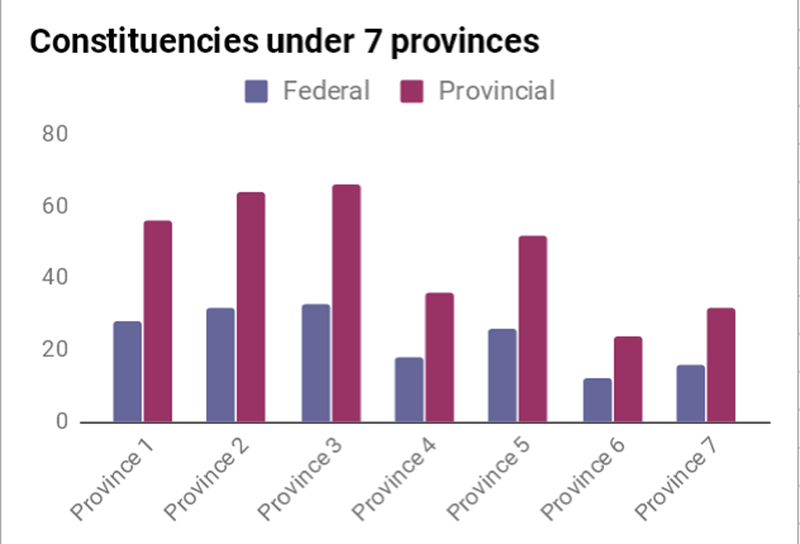
OR
Govt gets constituency delimitation report
Published On: August 31, 2017 06:15 AM NPT By: Ashok Dahal | @ashokpillar

- 35 districts have single constituencies, 21 will have two each
- Kathmandu has highest 10 constituencies
- Eight districts of Province 2 have 4 constituencies each
- One parliamentary constituency will have two constituencies for provincial assembly
KATHMANDU, Aug 30: The Electoral Constituency Delimitation Commission has submitted its report to the government Wednesday, weeks after the government announced the dates for parliamentary and provincial elections.
The commission has delineated 165 constituencies for the election of the federal parliament and 330 constituencies for the provincial assembly elections, in line with the new constitution. Article 84 of the new constitution promulgated in September 2015 has provisioned reducing the number of electoral constituencies to 165 from the existing 240.
Electoral constituencies for each provincial assembly will be double the number of constituencies meant for federal parliament as provisioned in Article 176 of the new constitution.
According to the report, 35 districts have only one constituency each and 21 districts have two constituencies each for the parliamentary elections. Similarly seven districts have three constituencies each and nine districts have four constituencies each. Jhapa, Rupandehi and Kailali have five constituencies each, Morang has six and Kathmandu has the maximum 10 constituencies. Constituencies, which have been delineated on the basis of population, have been reduced in most of the urban districts and hill districts while Kathmandu's 10 constituencies have been left unchanged. Similarly, several hill and mountain districts, which had only one constituency in the past, have also been left unchanged.
All eight districts of Province 2 will have an equal 4 constituencies each, according to the new delineation.
Under the new delineation, a maximum 33 constituencies are under Province 3, Province 2 with 32 constituencies has the second highest number, and Province 6 has just 12, the least number of constituencies. Likewise, Province 1 has 28 constituencies, Province 5 has 26, Province 4 has 18 and Province 7 has 18 electoral constituencies.
Electoral constituency delineation law requires that all 77 districts must be delineated at least one electoral constituency each for the parliamentary elections. The remaining 88 constituencies were delineated on the basis of population and geography, according to the members of the commission.
The decision of the commission cannot be challenged in any court of law. The new delineation comes into effect after the Election Commission publishes a notice in the Nepal Gazette.
The government has yet to pass the laws for the two vital polls, which must be conducted by January 2018 according to the constitutional provision, from parliament. The bills have been stalled in the parliamentary committee as some lawmakers from the ruling Nepali Congress (NC) are demanding that individuals convicted of corruption should be allowed to contest the polls three years after serving the jail term. Other parties have been strongly objecting to the demand.
The government had formed the commission on July 20 and given it 21 days. Later, its term was extended for 15 days. Former Supreme Court justice Kamal Narayan Das was the head of the commission while Madhav Adhikari, Bishwakalyan Parajuli and Ganesh Raj Karki were members.
You May Like This

Terai-Madhes unrest probe commission submits report to govt
Kathmandu, Dec 16: A High-level Probe Commission on Terai-Madhes unrest led by former justice of the apex court Girish Chandra Lal... Read More...

Lawmakers press govt to continue constituency dev funds
KATHMANDU, May 27: Parliamentarians have put pressure on the government to continue budgetary allocations for two parliamentary development programs in the... Read More...

New govt should follow course set by incumbent govt: PM Oli
KATHMANDU, July 30: Prime Minister KP Sharma Oli has said the next government was expected to follow the course set... Read More...




Just In
- Govt receives 1,658 proposals for startup loans; Minimum of 50 points required for eligibility
- Unified Socialist leader Sodari appointed Sudurpaschim CM
- One Nepali dies in UAE flood
- Madhesh Province CM Yadav expands cabinet
- 12-hour OPD service at Damauli Hospital from Thursday
- Lawmaker Dr Sharma provides Rs 2 million to children's hospital
- BFIs' lending to private sector increases by only 4.3 percent to Rs 5.087 trillion in first eight months of current FY
- NEPSE nosedives 19.56 points; daily turnover falls to Rs 2.09 billion















Leave A Comment